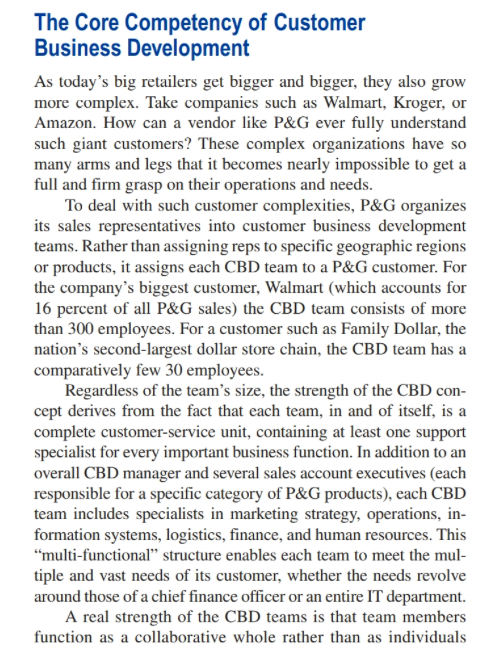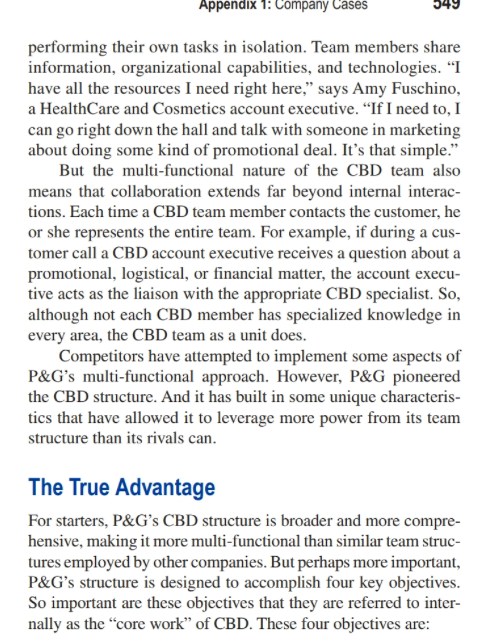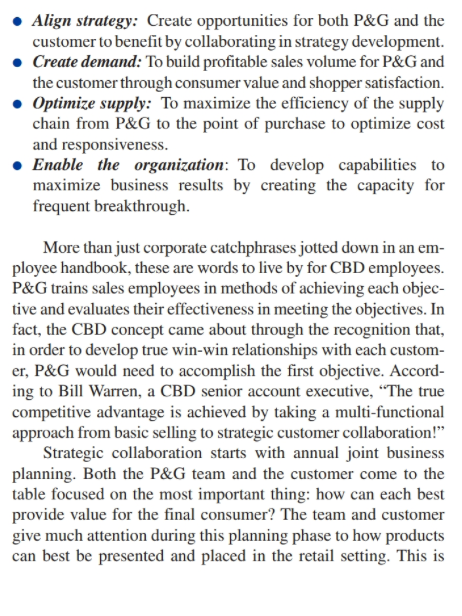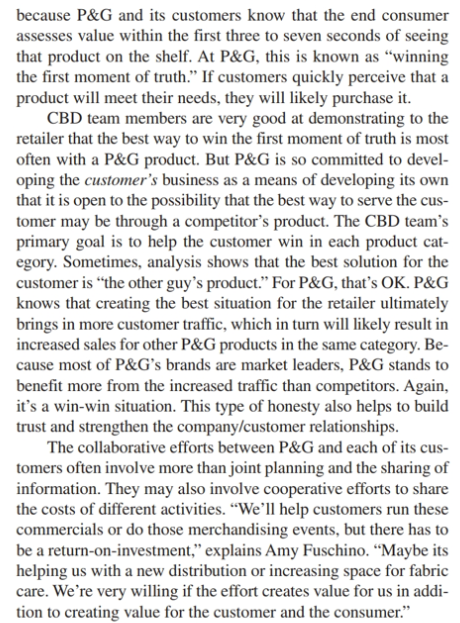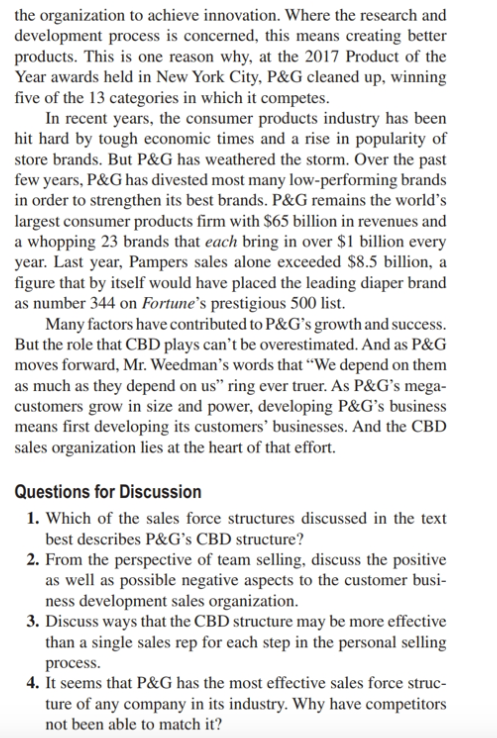Company Case 13 Procter & Gamble: Selling through Customer Business Development When it comes to personal selling, the term win-win gets thrown around so much that it has become a cliche. But at Procter & Gamble, the selling concept that the company benefits only if the customer benefits has long been a way of life. Since William Procter and James Gamble formed a family-operated soap and candle company in 1837, P&G has understood that if the cus- tomer doesn't do well, neither will the company. So although P&G boasts a massive sales force of more than 5,000 employees in the United States alone, P&Gers rarely utter the term sales. Instead, at P&G, they call it customer business development, or CBD. The title pretty much says it all. Rather than just selling detergent or toothpaste, P&G's philosophy is to grow its own business by growing the business of its customers, the thousands of retailers and wholesalers that distribute P&G's brands throughout the world. To these customers, P&G isn't just a supplier. It's a strategic business partner. "We depend on them as much as they depend on us," says Jeff Weedman, a CBD manager.The Core Competency of Customer Business Development As today's big retailers get bigger and bigger, they also grow more complex. Take companies such as Walmart, Kroger, or Amazon. How can a vendor like P&G ever fully understand such giant customers? These complex organizations have so many arms and legs that it becomes nearly impossible to get a full and firm grasp on their operations and needs. To deal with such customer complexities, P&G organizes its sales representatives into customer business development teams. Rather than assigning reps to specific geographic regions or products, it assigns each CBD team to a P&G customer. For the company's biggest customer, Walmart (which accounts for 16 percent of all P&G sales) the CBD team consists of more than 300 employees. For a customer such as Family Dollar, the nation's second-largest dollar store chain, the CBD team has a comparatively few 30 employees. Regardless of the team's size, the strength of the CBD con- cept derives from the fact that each team, in and of itself, is a complete customer-service unit, containing at least one support specialist for every important business function. In addition to an overall CBD manager and several sales account executives (each responsible for a specific category of P&G products), each CBD team includes specialists in marketing strategy, operations, in- formation systems, logistics, finance, and human resources. This "multi-functional" structure enables each team to meet the mul- tiple and vast needs of its customer, whether the needs revolve around those of a chief finance officer or an entire IT department. A real strength of the CBD teams is that team members function as a collaborative whole rather than as individualsAppendix 1: Company Cases performing their own tasks in isolation. Team members share information, organizational capabilities, and technologies. "I have all the resources I need right here," says Amy Fuschino, a HealthCare and Cosmetics account executive. "If I need to, I can go right down the hall and talk with someone in marketing about doing some kind of promotional deal. It's that simple." But the multi-functional nature of the CBD team also means that collaboration extends far beyond internal interac- tions. Each time a CBD team member contacts the customer, he or she represents the entire team. For example, if during a cus- tomer call a CBD account executive receives a question about a promotional, logistical, or financial matter, the account execu- tive acts as the liaison with the appropriate CBD specialist. So, although not each CBD member has specialized knowledge in every area, the CBD team as a unit does. Competitors have attempted to implement some aspects of P&G's multi-functional approach. However, P&G pioneered the CBD structure. And it has built in some unique characteris- tics that have allowed it to leverage more power from its team structure than its rivals can. The True Advantage For starters, P&G's CBD structure is broader and more compre- hensive, making it more multi-functional than similar team struc- tures employed by other companies. But perhaps more important, P&G's structure is designed to accomplish four key objectives. So important are these objectives that they are referred to inter- nally as the "core work" of CBD. These four objectives are:. Align strategy: Create opportunities for both P&G and the customer to benefit by collaborating in strategy development. . Create demand: To build profitable sales volume for P&G and the customer through consumer value and shopper satisfaction. . Optimize supply: To maximize the efficiency of the supply chain from P&G to the point of purchase to optimize cost and responsiveness. Enable the organization: To develop capabilities to maximize business results by creating the capacity for frequent breakthrough. More than just corporate catchphrases jotted down in an em- ployee handbook, these are words to live by for CBD employees. P&G trains sales employees in methods of achieving each object tive and evaluates their effectiveness in meeting the objectives. In fact, the CBD concept came about through the recognition that, in order to develop true win-win relationships with each custom- er, P&G would need to accomplish the first objective. Accord- ing to Bill Warren, a CBD senior account executive, "The true competitive advantage is achieved by taking a multi-functional approach from basic selling to strategic customer collaboration!" Strategic collaboration starts with annual joint business planning. Both the P&G team and the customer come to the table focused on the most important thing: how can each best provide value for the final consumer? The team and customer give much attention during this planning phase to how products can best be presented and placed in the retail setting. This isbecause P&G and its customers know that the end consumer assesses value within the first three to seven seconds of seeing that product on the shelf. At P&G, this is known as "winning the first moment of truth." If customers quickly perceive that a product will meet their needs, they will likely purchase it. CBD team members are very good at demonstrating to the retailer that the best way to win the first moment of truth is most often with a P&G product. But P&G is so committed to devel oping the customer's business as a means of developing its own that it is open to the possibility that the best way to serve the cus- tomer may be through a competitor's product. The CBD team's primary goal is to help the customer win in each product cat- egory. Sometimes, analysis shows that the best solution for the customer is "the other guy's product." For P&G, that's OK. P&G knows that creating the best situation for the retailer ultimately brings in more customer traffic, which in turn will likely result in increased sales for other P&G products in the same category. Be- cause most of P&G's brands are market leaders, P&G stands to benefit more from the increased traffic than competitors. Again, it's a win-win situation. This type of honesty also helps to build trust and strengthen the company/customer relationships. The collaborative efforts between P&G and each of its cus- tomers often involve more than joint planning and the sharing of information. They may also involve cooperative efforts to share the costs of different activities. "We'll help customers run these commercials or do those merchandising events, but there has to be a return-on-investment," explains Amy Fuschino. "Maybe its helping us with a new distribution or increasing space for fabric care. We're very willing if the effort creates value for us in addi- tion to creating value for the customer and the consumer."The collaborative efforts between P&G and each of its cus- tomers often involve more than joint planning and the sharing of information. They may also involve cooperative efforts to share the costs of different activities. "We'll help customers run these commercials or do those merchandising events, but there has to be a return-on-investment," explains Amy Fuschino. "Maybe its helping us with a new distribution or increasing space for fabric care. We're very willing if the effort creates value for us in addi- tion to creating value for the customer and the consumer." If the CBD team can effectively accomplish the first objective of aligning strategy and collaborating on strategic development, ac- complishing the other three objectives will follow more easily. For example, if strategic planning leads to winning the first moment of truth, not only does the consumer benefit, but both the retailer and P&G achieve higher revenues and profits as well. Through proper strategic planning, it is also more likely that both P&G and the customer will create greater efficiencies in the supply chain. It's Better to Give. . . Then to Receive By collaborating with customers, P&G receives as much or more than it gives. Among other things, P&G receives informa- tion that helps in achieving the fourth CBD objective, enablingthe organization to achieve innovation. Where the research and development process is concerned, this means creating better products. This is one reason why, at the 2017 Product of the Year awards held in New York City, P&G cleaned up, winning five of the 13 categories in which it competes. In recent years, the consumer products industry has been hit hard by tough economic times and a rise in popularity of store brands. But P&G has weathered the storm. Over the past few years, P&G has divested most many low-performing brands in order to strengthen its best brands. P&G remains the world's largest consumer products firm with $65 billion in revenues and a whopping 23 brands that each bring in over $1 billion every year. Last year, Pampers sales alone exceeded $8.5 billion, a figure that by itself would have placed the leading diaper brand as number 344 on Fortune's prestigious 500 list. Many factors have contributed to P&G's growth and success. But the role that CBD plays can't be overestimated. And as P&G moves forward, Mr. Weedman's words that "We depend on them as much as they depend on us" ring ever truer. As P&G's mega- customers grow in size and power, developing P&G's business means first developing its customers' businesses. And the CBD sales organization lies at the heart of that effort. Questions for Discussion 1. Which of the sales force structures discussed in the text best describes P&G's CBD structure? 2. From the perspective of team selling, discuss the positive as well as possible negative aspects to the customer busi- ness development sales organization. 3. Discuss ways that the CBD structure may be more effective than a single sales rep for each step in the personal selling process. 4. It seems that P&G has the most effective sales force struc- ture of any company in its industry. Why have competitors not been able to match it

